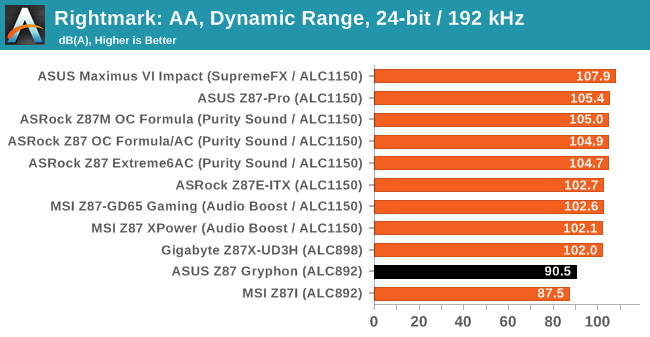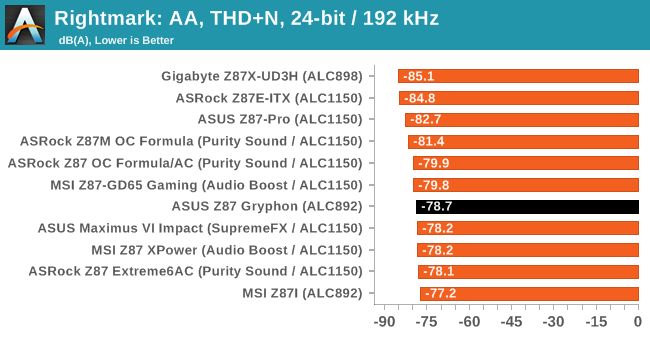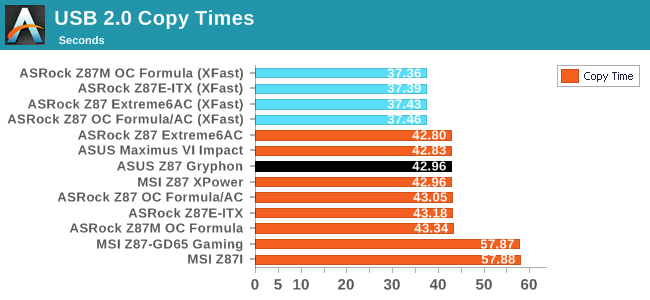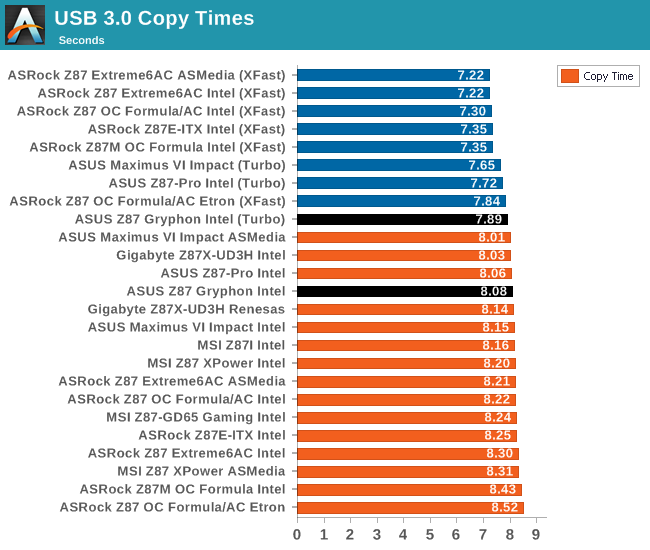ASUS TUF Z87 Gryphon Review
by Ian Cutress on February 3, 2014 10:00 AM EST- Posted in
- Motherboards
- Asus
- Z87
- TUF
System Benchmarks
Rightmark Audio Analyzer 6.2.5
In part due to reader requests, we are pleased to include Rightmark Audio Analyzer results in our benchmark suite. The premise behind Rightmark:AA is to test the input and output of the audio system to determine noise levels, range, harmonic distortion, stereo crosstalk and so forth. Rightmark:AA should indicate how well the sound system is built and isolated from electrical interference (either internally or externally). For this test we connect the Line Out to the Line In using a short six inch 3.5mm to 3.5mm high-quality jack, turn the OS speaker volume to 100%, and run the Rightmark default test suite at 192 kHz, 24-bit. The OS is tuned to 192 kHz/24-bit input and output, and the Line-In volume is adjusted until we have the best RMAA value in the mini-pretest. We look specifically at the Dynamic Range of the audio codec used on board, as well as the Total Harmonic Distortion + Noise.


Using the ALC892 for the Gryphon seems the right choice of codec, however it is limiting in terms of SNR compared to the ALC898 and above models.
USB Backup
For this benchmark, we run CrystalDiskMark to determine the ideal sequential read and write speeds for the USB port using our 240 GB OCZ Vertex3 SSD with a SATA 6 Gbps to USB 3.0 converter. Then we transfer a set size of files from the SSD to the USB drive using DiskBench, which monitors the time taken to transfer. The files transferred are a 1.52 GB set of 2867 files across 320 folders – 95% of these files are small typical website files, and the rest (90% of the size) are the videos used in the WinRAR test. In an update to pre-Z87 testing, we also run MaxCPU to load up one of the threads during the test which improves general performance up to 15% by causing all the internal pathways to run at full speed.


USB 3.0 Turbo boost provides an ample improvement in peak read speeds, although this does not translate in to much gain in the copy test.
DPC Latency
Deferred Procedure Call latency is a way in which Windows handles interrupt servicing. In order to wait for a processor to acknowledge the request, the system will queue all interrupt requests by priority. Critical interrupts will be handled as soon as possible, whereas lesser priority requests, such as audio, will be further down the line. So if the audio device requires data, it will have to wait until the request is processed before the buffer is filled. If the device drivers of higher priority components in a system are poorly implemented, this can cause delays in request scheduling and process time, resulting in an empty audio buffer – this leads to characteristic audible pauses, pops and clicks. Having a bigger buffer and correctly implemented system drivers obviously helps in this regard. The DPC latency checker measures how much time is processing DPCs from driver invocation – the lower the value will result in better audio transfer at smaller buffer sizes. Results are measured in microseconds and taken as the peak latency while cycling through a series of short HD videos - under 500 microseconds usually gets the green light, but the lower the better.

Once again the Z87 platform gives another 150+ result, showing that there is something fundamental with it causing a higher peak DPC than older Intel platforms.










62 Comments
View All Comments
bigboxes - Monday, February 3, 2014 - link
My P6T Deluxe Version 2 says otherwise. Agree with tim851.Samus - Friday, February 7, 2014 - link
Ahh, P6T...I miss my Gen 1 i7 system. What a solid platform.warezme - Saturday, February 8, 2014 - link
Firestrike or any benchmark numbers are irrelevant without knowing what resolution and settings. The same benchmark run at 800x600 and Low settings will score totally different number when run at 1920x1080 Ultra settings.A5 - Monday, February 3, 2014 - link
Huh. Probably would've bought this if it were out when I built my Haswell system last year.willdeng - Monday, February 3, 2014 - link
There's an error in the article. "From left to write are four USB 2.0 ports, a DVI-D port...":D
Senti - Monday, February 3, 2014 - link
I currently use Asus Sabertooth x58 MB and it works quite well: 211 base clock, CPU 2.8 -> 4.0 with minimal overvolt, RAM 1333 -> 1700, good placement of extension slots, PCI slot (I use it!).The only complain is NB is really hot and I was not comfortable with designed passive cooling so had to stick cooler on it.
It may not have many fancy features of top boards but indeed looks solid. MB before that was Biostar TPower x58 which died exactly a month after warranty ended.
Flunk - Monday, February 3, 2014 - link
Luckily they've fixed this problem because north bridges no longer exist they can't possibly get hot.Deelron - Monday, February 3, 2014 - link
Same here, have been running a i7 950 @ 4.2 ghz in the Sabertooth X58, and except an Ethernet port failure (which I'm not sure when it happened, I was using a dedicated card for Ethernet early on but accident plugged it into the built in after a computer move and it refused to be recognized by windows) it still runs like a champ.Iketh - Saturday, February 8, 2014 - link
maybe because you still had it disabled in bios?aznxk3vi17 - Monday, February 3, 2014 - link
"it is worth noting that with arrangement""Left to write"
Edits!